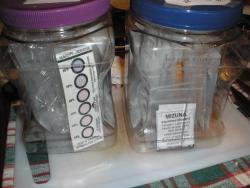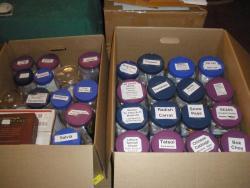The smartest idea I heard of for organizing a seed stash was to use those clear plastic pages that baseball cards are stored in, or a photo album with clear pockets.
But those would not fit into a tub that could be sealed air-tight! (Unless someone has a way to really seal a sweater box.)
I mostly store seeds in 2"x3" ZipLocs, bundled inside bigger ZipLocs or glassine bags, inside 3-pound peanut tubs. With silica gel in paper coin envelopes.
Below I'll describe my "best practice". At one point I ran out of silica gel and didn't buy more for a while, so I wasn't following my own advice for a while. But at least I am protecting them from VARIATIONS in humidity even when the silica gel is mostly exhausted.
And using desiccant is really only important if you want to keep as many things as possible viable for as long as practical. If you only want to save most seeds for 3-5 years and can afford to let the viability decline gradually, it's not worth the effort unless you like fiddle.
Check out the seed collection advice from Royal Kew Gardens.
Kew Royal Botanic Gardens post-harvest handling advice for seed collection / Millennium Seed Bank:
(They keep re-organizing their site so that everything is harder to find. There used to be an extremely handy list that let you download all the factual, technical PDFs one after another.
Now you have to travel many links and scroll past many uninformative photos to find each PDF that has actual, useful, information.
PDF:
http://www.kew.org/sites/defau...
http://www.kew.org/science-con...
http://www.kew.org/science-con...
http://www.kew.org/science-con...
http://www.kew.org/science-con...
http://www.kew.org/science-con...
http://www.kew.org/sites/defau...
http://www.kew.org/science-con...
Stored seed's viable life span approximately doubles for every 10% reduction in seed eRH.
("eRH" is equilibrium Relative Humidity.)
Seed collections should be dried to around 15% eRH for long-term conservation of orthodox seeds.
15% eRH works out to 4-7% moisture content (% water by weight), mostly depending on the seeds' oil content.
I use plastic Ziploc bags or big glassine envelopes to group together related seeds. For example, GREEN-stemmed Bok Choy, or non-red cherry tomatoes, or extra-early, extra-cold-adapted tomatoes.
Or, if I buy an ounce of some seed for trading, I split the ounce up into 15-20 packets with (say) 1/8th teaspoon each. I use 2"x3" ZipLoc baggies for these trade pkts - 1 cent each at Wal-Mart, or higher quality for less money online.
I label each trading packet with a double-sided pre-printed label inside the packet.
Then I pack those 15-20 identical trade packets into one big bag or envelope so they stay together and I know when I'm getting low on that variety of seed.
Then I pack the big bags or envelopes into peanut-butter tubs, each tub being a larger category, like "All Tomatoes" or "Carrots, Radishes and Other Roots".
Then (the key thing), I put about [b] one tablespoonful of fresh dry silica gel into a PAPER coin envelope[/b ] and drop that into the tub with the seeds.
Seal the tub as tight as possible and try to open it as seldom as possible.
Humidity passes right through paper, hardly impeded. So the silica gel in the PAPER coin envelope has full access to the air inside the tub. Since the tub seals FAIRLY well, that means the silica gel quickly reaches equilibrium with the air inside the tub, which drops to something like 10-15% RH.
Humidity leaks slowly through small plastic ZipLocs, both through the zipper and by diffusing straight through the thin, not-very-dense polyethylene plastic. This is good, because now the air inside each 2"x3" trade ZipLoc can SLOWLY release any trapped humidity and CO2. As those diffuse SLOWLY into the air in the big tub, the silica gel garbs it up very quickly.
This keeps the seeds themselves dry even if they were moist enough to start with that they were still metabolizing and releasing humidity. (The CO2 can also exit and oxygen can slowly enter.)
Once you get the seeds below 20% RH, the metabolism slows way down. That's what makes dry seeds last longer than humid seeds: slower metabolism consumes less stored food and leaves the seeds viable longer.



